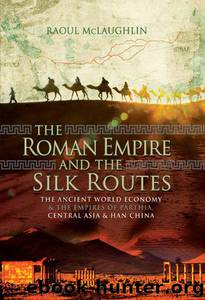The Roman Empire and the Silk Routes: The Ancient World Economy & the Empires of Parthia, Central Asia & Han China by McLaughlin Raoul

Author:McLaughlin, Raoul [McLaughlin, Raoul]
Language: eng
Format: azw3
Tags: HISTORY / Ancient / Rome
ISBN: 9781473889804
Publisher: Pen & Sword Books
Published: 2016-11-10T16:00:00+00:00
CHAPTER NINE
Black Sea Voyages
By AD 81 control over the Colchis region had been transferred to the Roman province of Cappadocia in central Asia Minor. Cappadocia bordered on Armenia and the provincial governor was assigned two legions to protect this frontier. This force was also responsible for garrisoning Colchis and assisting the allied kingdom of Caucasian-Iberia.
In AD 132, the strategically-minded Emperor Hadrian appointed a Greek named Arrian as Roman governor of Cappadocia. This posting included responsibility for the Caucasus and the Armenian frontier. The governor of Cappadocia commanded the XII Fulminate Legion based at Melitene and the XV Apollinaris at Satala to safeguard routes into Roman territory from Armenia and the neighbouring Parthian Empire.1
In addition to his military career Arrian had written a history of Alexander the Great that included a detailed account of his campaigns in India. He had also composed a ten volume account of Trajan’s eastern wars against the Parthian Empire which has not survived into modern times.2 During his term as governor, Arrian composed a tactical report called the Array against the Alani which described how the Roman army in the province of Cappadocia ought to be formed up for battle if a steppe people called the Alani breached the Caucasus Mountains and invaded Roman territory.
Hadrian paid particular attention to frontier defence and was responsible for Hadrian’s Wall, the 80-mile long barrier that divided Roman Britain from Caledonia (Scotland). He was also fond of touring the Roman provinces, so Arrian prepared a special report for the Emperor about conditions along the Black Sea coast.3 The work is composed in the style of a Greek sailing guide known as a Periplus (a circuit) which describes coastlines and sailing routes for mariners. Most of the document, known as the Periplus Ponti Euxini (Periplus of the Black Sea), is based on direct experience or details gathered from Roman informants. Arrian admired a fifth century BC Athenian historian named Xenophon who helped command a mercenary force of 10,000 Greeks in a military expedition against the Persian Empire. He therefore adopted the name ‘Xenophon’ as his literary identity.4
The Periplus of the Black Sea was written in Greek at a time when most educated Romans were fluent in this language and well-versed in Hellenic culture. The Historia Augusta confirms that Hadrian ‘was so deeply devoted to Greek studies in his youth that some people called him the “Greekling”.’5 In his report Arrian describes the entire circuit of the Black Sea, including places subject to Rome, regions ruled by allied regimes and territories controlled by independent nations. The Periplus includes details about ports, landmarks, marine hazards and sites that would have attracted foreign visitors.
Parts of this unique Periplus deal with Roman frontier administration and imperial defence strategies, but the report also suggests the progression of Greek trade routes around the Black Sea coast. It confirms that the Caucasus produced large amounts of high-quality timber, an essential resource for the seafaring communities of the Roman Mediterranean. It also verifies the export of linen to be woven into high-quality sailcloth and hemp used for ropes and rigging.
Download
This site does not store any files on its server. We only index and link to content provided by other sites. Please contact the content providers to delete copyright contents if any and email us, we'll remove relevant links or contents immediately.
International Integration of the Brazilian Economy by Elias C. Grivoyannis(87821)
The Radium Girls by Kate Moore(11895)
Turbulence by E. J. Noyes(7914)
Nudge - Improving Decisions about Health, Wealth, and Happiness by Thaler Sunstein(7522)
The Black Swan by Nassim Nicholas Taleb(6979)
Rich Dad Poor Dad by Robert T. Kiyosaki(6349)
Pioneering Portfolio Management by David F. Swensen(6202)
Man-made Catastrophes and Risk Information Concealment by Dmitry Chernov & Didier Sornette(5896)
Zero to One by Peter Thiel(5657)
Secrecy World by Jake Bernstein(4614)
Millionaire: The Philanderer, Gambler, and Duelist Who Invented Modern Finance by Janet Gleeson(4341)
The Age of Surveillance Capitalism by Shoshana Zuboff(4174)
Skin in the Game by Nassim Nicholas Taleb(4140)
The Money Culture by Michael Lewis(4048)
Bullshit Jobs by David Graeber(4047)
Skin in the Game: Hidden Asymmetries in Daily Life by Nassim Nicholas Taleb(3897)
The Dhandho Investor by Mohnish Pabrai(3672)
The Wisdom of Finance by Mihir Desai(3625)
Blockchain Basics by Daniel Drescher(3466)
